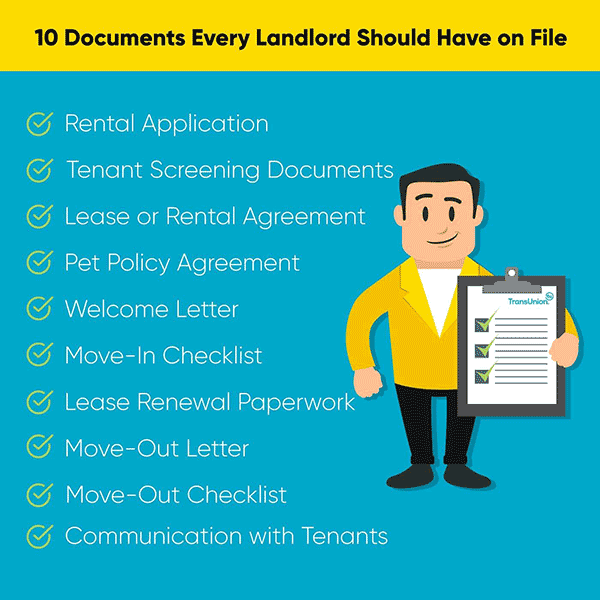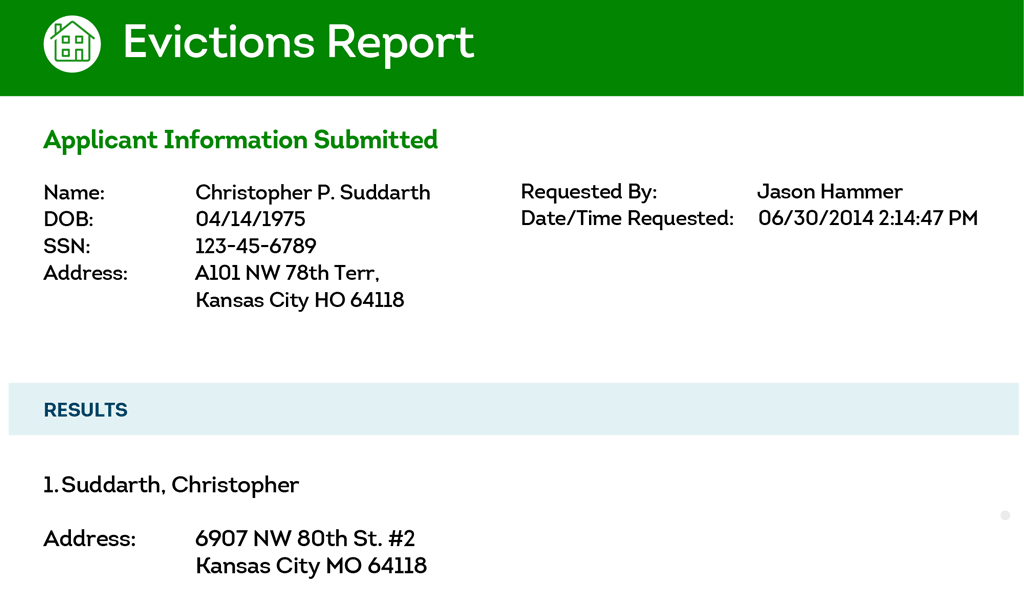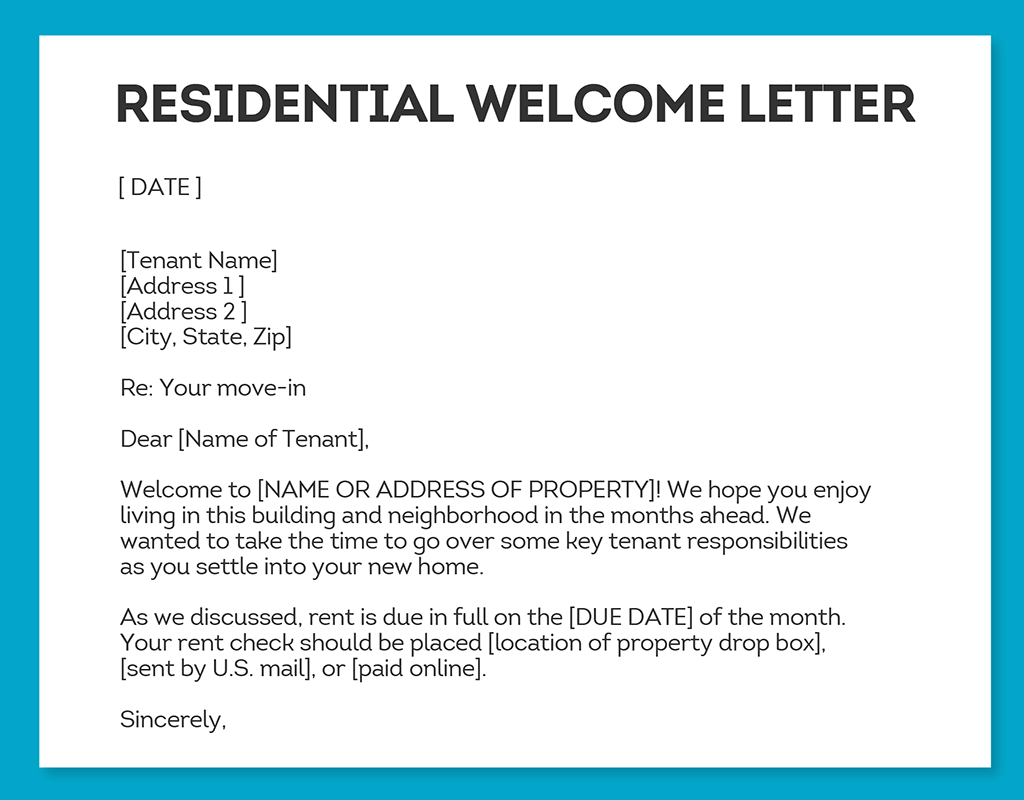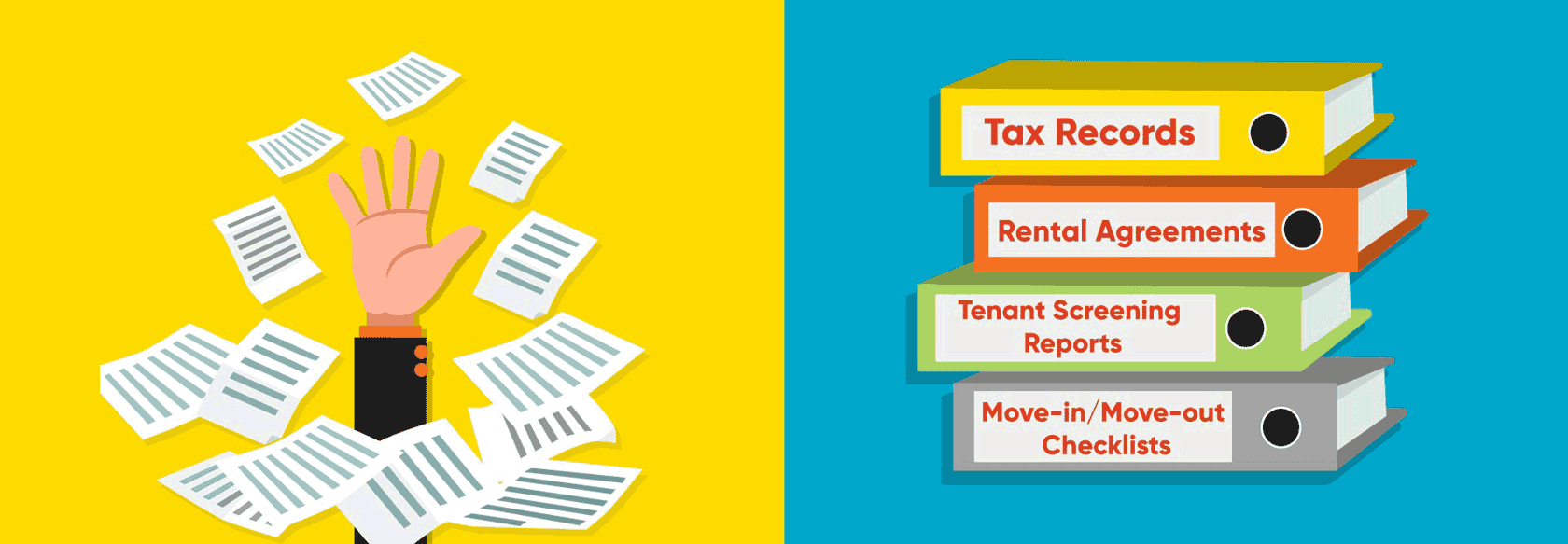Summary:
Keeping organized, detailed records is one of your responsibilities as an independent landlord. To help in the event of legal or tenant trouble keep documents, like the following, in good order: rental applications, tenant screening documents, lease or rental agreements, pet policies, welcome letters, move-in checklists, renewal paperwork, move-out letters, and move-out checklists.
Disclosure: This content, except as otherwise indicated or stated on this site, is the property of TransUnion Rental Screening Solutions, Inc. This content is for educational purposes and for convenience only. Trademarks used are the property of their respective owners, and no endorsement or affiliation is implied. The information presented in this content is “as is” without warranties of any kind, and specifically is not represented to be complete and does not constitute legal advice, and is subject to change without notice. You are encouraged to check these terms from time to time for changes, and by accessing this site you agree to these terms and all terms listed. Laws and regulations may vary by state and locality. Consult your own counsel if you have legal questions related to your rental property practices and processes.
Disclaimer: Remember that this material is intended to provide you with helpful information and is not to be relied upon to make decisions, nor is this material intended to be or construed as legal advice. You are encouraged to consult your legal counsel for advice on your specific business operations and responsibilities under applicable law. Trademarks used in this material are the property of their respective owners and no affiliation or endorsement is implied.
In the great feast of life, landlords have plenty on their plate. There’s the meaty task of finding great tenants and the heavy helping of fixing leaky faucets. Throw in a daunting side of avoiding evictions and it’s almost more than an independent landlord can stomach.
To make matters worse, landlords must fit a towering stack of rental paperwork on top of an already overflowing platter: security deposits, rent payments, receipts for maintenance repair—the list goes on and on. Whether you want to itemize your tax return or comply with the law, chances are that you may need a form to document the transaction.
Keeping documents organized is key to helping your business run smoothly. Failing to produce even a single document could mean losing thousands through potential lawsuits or tenant issues.
Use this list to help keep track of what you have (and what you’re missing) when it comes to rental paperwork
Why Should Landlords Keep Records
There are many reasons independent landlords should keep thorough, detailed records. Staying organized and keeping strategic files can help landlords:
- Better protect against potential lawsuits
- Contend with tax responsibilities
- Promote transparency with tenants
Help Protect Against Litigation
Even if your tenant screening process goes smoothly, you may find yourself in a dispute with a tenant who seemed like a great fit. According to Realtor.com, the most common reasons tenants sue their landlord include:
- Setting policies that discriminate:
- Asking inappropriate screening questions: Stick to objective, unbiased prompts regarding income level and rental history. Avoid application or screening questions that could be perceived as subjective or discriminatory.
- Using generic or outdated lease agreements: If you don't update your lease agreements regularly, it might contain outdated terms. A generic lease used as an umbrella agreement may not hold up in court and could be manipulated or misinterpreted to your tenant’s benefit.
- Charging excessive late fees: According to legal site NOLO, there are laws that govern the limit on late rent fees, which vary by state. Make sure your lease outlines when a fee will be assessed and exactly how much your tenant will pay.
- Violating a tenant’s right to privacy: When you lease your property, you can’t enter the unit whenever you please. Except in an emergency, you’re typically required to provide advance notice before showing up. Urgent entry situations and notice timeframes should be explicitly stated in your lease. Note that these housing laws often vary by state, according to the U.S. Department of Housing and Urban Development.
- Wrongly using or withholding a security deposit: If a tenant moves out, take pictures of any damage you notice beyond normal wear and tear. Only a small population of landlords report returning a security deposit in full, so it’s likely you may need to keep a portion of the deposit to cover repair costs.
If repairs are required, you may need to provide your former tenant with an itemized receipt of expenses—including the billable labor and raw materials used—and return the remaining amount within a specified time frame or risk a lawsuit.
- Ignoring dangerous conditions in or around the property: Tenants have the right to a livable space. You have a responsibility to provide some necessities such as heat, water, sturdy floors, structurally intact walls, strong roof, or absence of significant danger (e.g. from lead, asbestos, mold, etc). In your rental agreement, spell out what maintenance you’re accountable for and which repairs fall on the tenant.
Important Note: All considerations above may vary depending on where you live. Check your area’s local laws and please consult your legal counsel for advice on how these may impact you.
Documentation for Legal Action
Landlord forms and rental documents can also provide evidence if you ever need to take action against a renter. Here are some common situations where landlords might take action against a renter:
- Unpaid rent: 84% of landlords agree that a renter’s failure to pay is their top concern. If you’re struggling with a tenant who hasn’t paid, you may have to send a form notifying the tenant to pay rent or quit the lease. If that does not work, you may be able to file an eviction and sue for rent owed.
- Damage to the property: Your rental document should state you have the right to deduct expenses from the security deposit to repair property damage beyond normal wear and tear. If the deposit is insufficient to cover all costs, you may be able to collect the rest through court action.
- Recover money due to an early move-out: Tenant turnover and rental vacancies can land a serious blow on your income—especially if a tenant moves out abruptly or violates their lease. In some cases, you may be able to recover lost rent in court.
Pro Tip:
Individual circumstances vary significantly. With any situation that may result in a lawsuit, please consult with your legal counsel before taking any action.
Streamline Your Tax Filing Responsibilities
During tax season, proper documentation ensures a smooth, surprise-free filing process. On top of personal tax obligations, landlords have additional responsibilities. If you own real estate and run a rental business, you likely report all related income on your annual return.
Fortunately, landlords may qualify for money-saving tax deductions. However, to claim these deductions, you must have accurate records and should consult with a tax professional.
Promote Transparency
Creating and maintaining a respectful relationship with tenants is a priority for landlords. Providing your renters with detailed documentation throughout the duration of their tenancy encourages a mutually beneficial relationship.
Documentation can be used to welcome tenants, explain expectations upfront, and streamline communication. By promoting transparency, landlords start each tenant relationship off on the right foot and may help reduce tenant payment problems.
It’s clear that storing and organizing landlord documents can help protect against litigation, simplify tax filing, and improve your tenant communication. Next, let’s look at the specific documents you should have on-hand.
What Forms and Documents Should a Landlord Keep on File
While not exhaustive, this list of important landlord documentation is a great starting point. Regulations do vary by location, so always check your area’s local laws.

1. Rental Application
Rental applications inform you of a prospective tenant’s details and are often a first step to qualify or deny an applicant. Requiring a rental application can help reduce the chance of placing a risky tenant in your unit.
A typical rental application may cover:
- Contact information
- References
- Current and previous residence information
- Employment history
- Proof of income
- Authorization to pull a credit report and criminal record
Keep all application materials, including those from rejected applicants.The length of time you need to keep the documents depends on federal and state laws.
How to Create a Rental Application:
There are several different ways to put together a rental application and ensure you’re asking the right questions.
- Refer to your local real estate association
- Create your own, following trusted guidance
- Find and adapt a rental application from the Internet
Whatever method you choose, it’s a good idea to run your application by an attorney specializing in rental law before putting it in front of potential tenants.
Pro Tip:
As you create your rental application, make sure you’re setting yourself up for success from the start. Knowing what questions to ask on a rental application can help you find better tenants.
2. Tenant Screening Documents
After collecting applications, you should vet prospective tenants. According to SmartMove data, more than 95% of landlords believe tenant screening is beneficial and helps them sign with higher-quality tenants.
General Principles to Consider for Your Tenant Screening Policy:
- Create rental criteria (such as minimum required income), document these standards, and apply them universally across all applicants.
- Bonus Tip: Income Insights helps you confirm your rental applicant actually makes as much as they say they make.
- Keep a list of pre-screening questions and ask every applicant the same set.
- Call tenant’s listed landlord references and employers, sourced from their rental application, and be prepared with a list of reference questions.
- Run background checks through a well–established service. You may want to include criminal background reports and an online rental credit check.
- Bonus Tip: ResidentScore helps predict evictions 15% better than a traditional credit score alone.

3. Lease or Rental Agreement
A lease or rental agreement certifies a tenant can occupy a property for a specified period of time. It also defines the rights and responsibilities of both landlord and tenant. As noted earlier, the lease can be your ally if it comes to future disputes.
Rental terms may vary, but should generally include the following:
- Your role, duty, and rights as a landlord
- Tenant’s responsibilities and rights
- Dates and terms of the lease
- Protection of property and tenant accountability
- Payment terms, including when rent is due and how to pay
- Outline of the eviction process
According to a SmartMove user survey, the top two concerns of landlords are: 1) renter payment problems and, 2) a tenant’s eviction history. Writing a detailed lease is essential, as it’s proof of the signed agreement you made with the tenant and will be useful if you ever needed to take action against a renter.
Pro Tip: Keep the lease, even after the tenant moves out. A landlord’s obligations don't always end when the lease ends. The IRS can audit a landlord long after an agreement terminates. If a disputes arise later, this documentation might be a critical element.
4. Pet Policy Agreement
If your rental property is pet-friendly, have a documented pet policy on file. Tenants should sign this landlord document, which may include the need for an additional pet deposit, pet rent, cleaning, or expected pet owner responsibilities.
5. Welcome Letter
A welcome letter is a friendly greeting for your tenant that also provides helpful information. It may explain details such as:
- How to set up utilities
- How to get renter’s insurance
- How to pick up keys
- How to use laundry unit/room
They may be simple, but welcome letters ease the transition for your tenant and benefit your landlord-tenant relationship. Like any landlord documents, it's important to consider rental regulations in your area to make sure the letter is appropriate.
Here’s a sample excerpt from a welcome letter:

Pro Tip:
Consider consolidating your landlord forms by combining the tenant welcome letter with a move-in checklist. Having good communication is one way to help keep high quality tenants from leaving
6. Move-In Checklists
A move-in checklist helps you keep track of the condition of your property and holds your tenants accountable for any damage that occurs while residing there. Without the checklist, it’ll be your word against theirs post move-out.
This rental document also provides peace of mind for tenants, as it assures you won’t charge for pre-existing damages. Go over the checklist with your tenants at move-in and again at move-out. This will help determine if the tenant has damaged your property beyond normal wear and tear.
7. Lease Renewal Paperwork
Lease renewals can help landlords save time and money and offer many benefits, including:
- Eliminating the cost of finding new tenants
- Reducing the risk of vacancy
- Reducing the risk of an incompatible tenant moving in
- Retaining a tenant that’s already familiar with lease terms
Be proactive with your renewals and ask your tenant 90 days in advance whether they wish to renew the lease. There are many sample renewal applications available online that you can use as a starting point.
8. Move-Out Letter
If your tenant plans to vacate the property, you may want to send a move-out letter about a month before the lease ends. This landlord document sets expectations, such as a tenant’s responsibilities before vacating the property and how you’ll return the security deposit.
On average, one month of vacancy costs a landlord $1,750, but time wasted due to cleaning, overstays, or missing keys can lead to greater loss. Keeping good documentation can help reduce vacancy and ease the stress of turnover.
Create a move out letter that includes at least the following:
- Cleaning requirements and expectations
- Date and extent of your final rental inspection
- Security deposit deductions
- Important reminders
- Request for a forwarding address
9. Move-Out Checklist
A tenant move-out checklist spells out a tenant’s responsibility when vacating your rental property. Consider attaching this checklist to the lease agreement, so your tenant understands their responsibilities right from the start.
A move-out checklist is mutually beneficial. For landlords, the rental space is left in better condition. For tenants, there's a better chance of getting the full security deposit back.
10. Communication with Tenants
Within your rental documents file, keep track of all correspondence with tenants from the moment they apply until the moment they move out. This may include:
- Email chains
- Text messages
- Dated notes from telephone/in-person conversations
Should you ever need to contest a conversation, having detailed records could help protect you.
How Landlords Should Store Important Documents
One of the most important tips for new landlords is to keep digital records. Scan all your rental documents and save the files on cloud storage so that your forms stay organized. It’s wise to keep hard copies in something like a fire-retardant safe deposit box, as well.
Then, when you no longer need the documents, it’s essential to dispose of them in the proper way. Guidance from the Federal Trade Commission states that any documents containing protected consumer information cannot just be thrown out––they must be destroyed completely.
How Documentation and SmartMove Help Can Protect Your Rental Investment
There’s no sugarcoating it. Being an independent landlord isn’t always a picnic. If you don’t protect your investment with proper documentation and tenant screening, you could be left with nothing but crumbs. SmartMove provides near-instant, online tenant screening reports that give landlords crucial background data regarding prospective renters.
Unfortunately, all the documentation in the world can’t protect you from a low quality tenant. You need to do your best to choose high quality renters from the start. Criminal records checks search through hundred of millions federal and state-level crime records, for a potential match for your applicant. Meanwhile, eviction checks help discover if there are any eviction-related court proceedings connected to your potential tenant.
Get the data to help back up your gut instinct. Help verify your applicant’s income and financial track record with credit check and Income Insights. Plus, included with every SmartMove screening package, ResidentScore which helps you predict future evictions 15% better than a traditional credit score alone.
Easy, online screening means landlord background check documentation is accessible . Fast, on-demand online screening means you can even screen tenants and potentially sign the lease on the same day.
Choose feast over famine. Screen with SmartMove and protect yourself from the start.
Know your applicant.
Additional Disclosure:
The information posted to this blog was accurate at the time it was initially published. We do not continue to guarantee the accuracy or completeness of the information provided. The information contained in the TransUnion Rental Screening Services, Inc. blog is provided for educational purposes only and does not constitute legal or financial advice. You should consult your own attorney or financial adviser regarding your particular situation. For complete details of any product mentioned, visit www.transunion.com. This site is governed by the TransUnion Rental Screening Privacy Policy Privacy Notice located at TransUnion Rental Screening Solutions, Inc. Privacy Notice | TransUnion.



